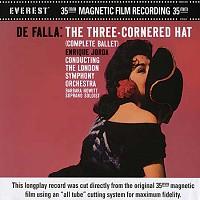Everest's Original 35MM Tapes Used To Cut LPs For The First Time
While Mercury gets all the 35MM audiophile glory, Everest also produced a series of sonically spectacular LPs, many recorded on 35MM magnetic film by the late engineer-turned audio columnist Bert Whyte. The advantages of sprocketed 35MM magnetic film are zero “print-through,” minimal “wow and flutter,” higher signal to noise ratio and wider dynamic range than conventional ¼” or ½” recording tape.
Classic Records licensed 20 of the original 35MM tapes and plans on reissuing them over the next year. According to Classic’s Mike Hobson, while the recording electronics used to produce these tapes were outstanding, that was not the case on the playback side.
In order to get the most from these tapes, Classic brought History of Recorded Sound’s Len Horowitz on board for a total rebuild of a vintage Westrex 1551 playback deck. Horowitz fitted the machine with new playback heads and vacuum tube electronics. The result is far better sound quality than what was originally obtained from the tapes as anyone who compares this reissue to the original will immediately hear.
The tape-to-disc transfers done at Bernie Grundman’s are absolutely spectacular, based on the ones I’ve so far heard. I have an original of this recording and a few others and while they are quite fine sounding, they also tend to be bright and hard. I was fortunate to attend the transfer of this title and got to hear the tape playback. At first Grundman used an original pressing as a reference but that proved useless as the tape playback was vastly superior. “Re-creating” the original vinyl was not an option.
The final reissued LP is total vindication for the process. The harmonic textures are rich, full and warm, string tone is deeply burnished and voluptuous, winds are airy and the brass glows like the late afternoon sun. The enormous soundstage heard on the original has been retained, while in all other ways the reissue stomps all over a clean first pressing. The orchestral sound jumps from the speakers, producing a sonic spectacular that will wow you every play.
Oh, the music! De Falla’s ballet incorporates all of the elements one expects from Spanish music: castanets, handclapping, Gypsy/flamenco passion and other familiar musical motifs. Originally staged in 1919 with choreography by Sergei Diaghilev and costumes and scenery by Pablo Picasso, “The Three Cornered Hat,” was an instant hit and quickly became part of the popular classical music repertoire. Beyond that I’m afraid I’m ill equipped to analyze the music or critique the performance relative to others in the catalog.
One needn’t see the dancers to enjoy the music, especially when it’s as well recorded and presented as it is on this new Classic reissue. As an entré to classical music, this abundance of riches can’t be beat musically and sonically.



